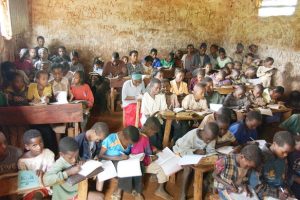
Removed from the list of World Heritages in Danger in 2017, in recognition to signs of improvement, the Simien Mountains National Park’s situation came under intense scrutiny because of the recent blaze. Known for its being sanctuary of the precious and yet the nowhere else to be found Gelada baboon, the Simien fox and the Walia ibex, the UNESCO registered Park made headlines, not for its riches, but as it was hard hit by a raging blaze.
The world heritage park in northern Ethiopia is home to striking terrain including escarpments, deep valleys and a high plateau, home to rare Walia ibex and Gelada baboons. Considered as the Roof of Africa, harboring the highest mountain peaks, the Semien Mountain National Park offers one of the wonders of wildlife. While the fire risks some of scenery, it inflicted fear on possible threat on the must see creatures inhabiting the site.
It as well is ringing a bell of warning to the entire nation. In fact, the incident also sends a chilling message to the world grappled with the gruesome reality of climate change. The blaze whose real cause is yet to be determined required the full weight of the nation. To make matters worse, the fact that the country lacks the means and the expertise of firefighting created havoc and frustration.
The park is also one of the best naturally choreographed beauties being at the center of nature enthusiasts and tourism goers. Surrounded by chains of mountains, beautified by the rarely seen endemic wild animal, the park in fact is the uncensored natural scene The raging fire destroyed 342.9 hectares of grassland. It was an uphill battle that countries came into rescue with Israel sending a team of experts and Kenya sending firefighting helicopter.
It was until recently that the burning ended, but the threats still looms. It was until recently that Ethiopian officials announced that coordination among experts helped put off the fire after weeks of burning with an Israeli embassy official who joined the contingent that arrived in Addis Ababa to help in the effort tweeted their success.
“Mission accomplished! The application of advanced methods and the joint efforts made by the Ethiopian authorities and the #Israeli firefighters mission resulted in the extinguishing of the wildfires in the SimienMountains!” he posted on Twitter. The park is listed as a UNESCO World Heritage Site and its summit, Ras Dashen (4,550m), is the highest peak in Ethiopia.
Lake Tana, the source of the Blue Nile, also lies in the northwestern portion of the Ethiopian Highlands. The impact has been intense that it played in political debate and media headlines. The wildfire that raged the park has put the must-see site once again into the focus of wildlife activists, conservationists and tourists. Because the fires potentially threatened the lives and economic well-being of the communities, they had a significant interest in suppressing the fires as quickly as possible.
Despite the lack of resources, the community used whatever means were available: shovels, sticks and wet tree branches. The firefighting efforts were innovative because they were unable to rely on a steady supply of tools and resources. The park which is an inseparable part of the surrounding community cannot be more hit by the fire and more worrisome to the people living alongside of it. It is no surprise that the community had been the first responders to the looming threat though their initial efforts tough made little headway, provoking public outcry and invoking government attention.
Volunteers, residents of nearby Debark town, university students and members of tourist associations, have battled to get it under control but it proofed challenging to be brought under control. But again national counter efforts made little gains. The problem reaching breaking point has awakened the entire people and sensitized conservationists.
In fact, the heritage that has had its own fair share of challenges has become not only national matter but also international issue. Had there been adequate fire awareness and basic firefighting equipment, the fires could have been controlled much sooner, reducing the impact of the disaster. Lack of far-sightedness seems to have contributed to the less capacity of fighting with own capacity, instead to depend on external assistance to provide financial resources, manpower and expertise.
The national government is unable to play a relatively small role in the fire response, for certain reasons such as negligible resource and experience in forest fire management. In addition, there was no focal point institution in Ethiopia to address forest fire disasters. However, immediately after the fire was put out, the issue faded away completely, even at government level.
Ethiopia’s preparedness and firefighting capacity is almost the same as it was before; however, the threat of fire remains high, said experts under a condition of anonymity. It was reported that a committee formed from federal and regional governments is sent to the area in order to investigate the cause of the fire accident and help control the fire, according to Belayneh Ayele, director at Amhara Region Environment, Forest Wild Animal Protection and Development Authority.
That was the second wildfire in the country in less than a week. Bale National Park in South Ethiopia experienced similar situation. Seating in a total area of 412 square kilometer, the fire almost resulted in the devastation of over 60 hectars of land. The geographic scene with breathtaking hills and refreshing wind could make a better adventure fortrekking but it also made the wildfire to track.
Same problem rolls in even other parks. According to various reports, a threat associated with an ever-developing and an increasingly populated area, frequent wildfire remains one of the biggest threats to the park. The 220 sq-km (84 sq-miles) park, sometimes referred to as the “Roof of Africa” given that it forms the largest continuous area of elevation on the continent.
Due to the delays in the government’s response and the minimal resources available to counter the fire, the most effective firefighting tools were the community members themselves. In nearly all areas that experienced serious fires in 2000, the communities either mobilized themselves or were mobilized by the local government to use whatever tools and resources were available to them. Perhaps more importantly, local suppression strategy often depend upon indigenous local knowledge, not external input, according to research by DechassaLemessa.
While the “high-tech” method of aerial firefighting was proving ineffective in Bale, communities on the ground were using such simple techniques as wet tree branches or cutting the leaves of trees at the periphery of the fire as containment tools. Community knowledge proved to be relatively successful in controlling the fires, an indication that such knowledge should be afforded a greater degree of respect in the future. The forest management knowledge developed over thousands of years of living on the land should be respected as a valuable resource.
The Ethiopian Herald May 17/2019
BY DESTA GEBREHIWOT





